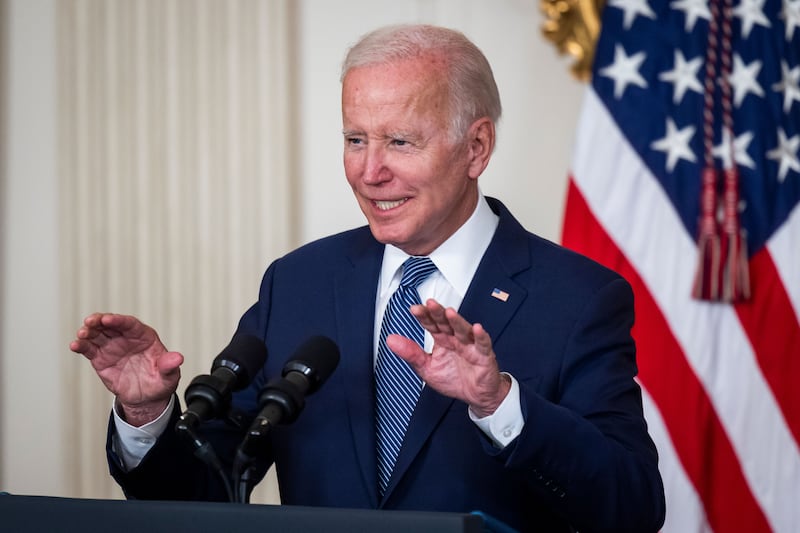Several weeks ago, I wrote a newsletter that I foolishly considered somewhat anodyne, not likely to get much reaction. It seemed probable that the initial estimate for gross domestic product growth in the second quarter would be negative and that many people would declare that this meant the United States was in a recession. So I spent some time pedantically explaining why we don’t actually use “two negative quarters” to define recessions and why, given other data, America probably wasn’t in one.
Silly me. I immediately received the biggest wave of hate mail I’ve got since the Iraq War, although it tapered off as many other economists and institutions declared that we weren’t in recession – not yet, anyway – and it pretty much vanished after the subsequent monster jobs report.
But absence of a recession aside, one question I get asked is, what happened to the “Biden boom” that I – and many other economists – predicted?
And the answer is, it happened! But Americans aren’t feeling it, and it’s worth asking why.
So, about that boom. Let’s consider jobs gained since Inauguration Day under Joe Biden.
Obviously, there was a plunge in employment in 2020, as the Covid-19 pandemic forced the temporary shutdown of much of the economy. But one thing I haven’t seen widely noted is that job growth under Biden has been so fast that the economy added substantially more jobs in the past 18 months than were added in Donald Trump’s first 37 months – that is, before the pandemic recession began.
I’m not saying that Biden deserves all the credit for this employment boom. When he took office, the US economy was already in the process of recovering many of the jobs lost to the pandemic, although unemployment has fallen much faster than most forecasters were expecting in late 2020. But it’s kind of a moot point, anyway: presidents often, dare I say usually, receive credit or blame for economic developments that have little to do with their policies.
So why doesn’t Biden get credit for the Biden boom, which is a real thing?
False assertions
Part of the answer is that people may not know about it. Some polling suggests that the public may not be aware that we’ve been creating jobs at all, let alone at a record pace. And we’re in a partisan environment where politicians – let’s not both-sides this, right-wing politicians – can make obviously false assertions and have their supporters believe them. A couple of weeks ago, Trump told a crowd that gas in California costs $8.25 a gallon and nobody laughed. (It was actually $5.43 at the time.)
Yet there has, of course, been a genuine dark side to the Biden boom: inflation. And people really dislike inflation. They would probably dislike it even if their incomes were keeping up. They definitely dislike it when prices are rising faster than wages, so the purchasing power of their income falls.
And inflation has, in fact, been outpacing wages since Biden took office; employment may be way up, but the real wages of those with jobs are down. We can argue about whether this episode is bad enough to justify the extreme negativity of public opinion about Biden and his economy, but it’s certainly a bad thing.
But what accounts for the inflation? That’s a huge subject, with scores if not hundreds of duelling studies, but there’s one fairly simple point that I think is clear: the inflation that people really hate, inflation that runs ahead of wage growth, is overwhelmingly a result of forces that were outside the control of the Biden administration or any US policymaker.

The Federal Reserve, which usually runs US macroeconomic policy – the White House sometimes matters, but most of the time, it’s the Fed’s show – has long made use of the concept of “core” inflation: inflation excluding volatile components, typically food and energy. The idea is that core inflation gives a better picture than the overall number of whether the economy is running too hot.
In the post-pandemic era, with wild swings in things like the price of used cars, there have been questions about whether traditional core inflation excludes enough stuff. But for today’s purposes, I’ll stick with the traditional definition.
The big critique of Bidenomics, which has a lot of justification, is that big spending last year produced too much of a Biden boom, which led to a rise in core inflation; now the Fed has no choice but to squeeze the economy with higher interest rates until underlying inflation comes down.
Cost of living
But this policy mistake, if that’s what it was, has little to do with the reasons Americans are unhappy despite the jobs boom.
Inflation has run faster than wage growth, so real wages are significantly down.
I’m not saying that Americans should care only about core inflation; what matters for families is the cost of living, in all its components. However, the component of inflation that upsets Americans most – inflation faster than wage growth – is overwhelmingly a result of forces, like the prices of globally traded commodities, that weren’t driven by US economic policy.
[ Biden signs landmark climate and healthcare bill into lawOpens in new window ]
In other words, the reasons people feel so bad about the US economy have a lot to do with events outside US control.
That won’t stop voters from punishing Democrats for inflation, although the odds are that, over the next few months, we’ll see a reversal of what happened over the past year and a half: job growth will probably slow, but many prices will come down, especially gasoline, which dropped to an average of about $3.95 a gallon last week.
Anyway, the Biden boom was real. It just got overshadowed by inflation, much of which had nothing to do with US policy. – This article originally appeared in the New York Times

















